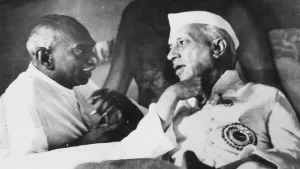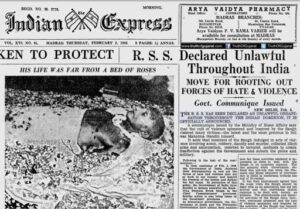There was once a revolutionary who spent 30 long years in a variety of British prisons. Of these 30 years, six were spent in the dreaded cellular jail of Andaman, yet he did not write one single apology letter or clemency petition to the British Imperialists. The name of that legendary revolutionary, which has almost been forgotten from out national memory, is Trailokyanath Chakraborty.
Known as ‘Maharaj’ in revolutionary circles, Chakraborty was born on August 2, 1889 in the Mymensingh district of undivided Bengal. Taking inspiration from the Swadeshi movement that arose in response to the partition of Bengal in 1905, Chakraborty jumped into the freedom struggle at the tender age of 17 and joined the Dacca (now Dhaka) Anushilan Samiti in 1906, becoming an active member and organiser.
After the arrest of Pulin Behari Das, founder-president of the Dacca Anushilan Samiti, in the Dacca conspiracy case of 1910, Chakraborty, along with Pratul Chandra Ganguly, took charge of the organisation and successfully revived it as one of the most dreaded opponents of the colonial regime.
Chakraborty was arrested for the first time in 1908 and was imprisoned for six months. With this arrest ended his formal education and began his journey to several prisons across the Indian subcontinent; a journey which continued even after the British left the country.
He was arrested for the second time in 1912 and was charged with the murder of a police constable, but was later released due to a lack of evidence. His third arrest came in 1914 when colonial police came across some Anushilan documents that proposed plans to incite native troops to rebel against the British during the First World War. As the ring-leaders of the conspiracy, Chakraborty and Ganguly, along with 42 others, were arrested and put on trial in the Second Barisal Conspiracy Case. The court found them guilty of waging war against the King-Emperor and sentenced them to 10 years imprisonment.
After spending some time in the Barisal and Presidency jails, Chakraborty was transferred to Andaman’s Cellular Jail in 1916. In the Andamans, Chakraborty, like many of his other comrades, suffered inhuman torture. But his revolutionary spirit refused to die down.
When many of the revolutionaries lodged in the Cellular Jail decided to protest against the brutal torture and unbearable living conditions, Chakraborty joined them. This decision also caused an interesting rift between the revolutionaries. In this regard Chakraborty wrote in his autobiography:
“The inmates of Cellular Jail got divided into ‘naram’ (moderate) and ‘garam’ (radical) factions. The former consisted of the Savarkar brothers and Pulin babu who already had spent considerable time in the Cellular Jail and had suffered a lot. They had protested against their condition and were able to secure some amount of benefit for themselves. Now they were close to the jailor and superintendent. They refused to let go of their ‘benefits’ and join our struggle”.
Still, Chakraborty joined the hunger strike, despite a weak body and his suffering from Asthma.
After spending seven years in the Andamans, Chakraborty was transferred to Bengal’s Alipore central jail in 1921 and was finally released three years later. After his release, he took up a teaching job at South Calcutta National School but refused to take any salary. During this period, he also tried to print fake currency notes in order to raise funds for the revolutionary movement, but his attempts ended in failure.
By the end of 1924, he was arrested again and sent to Mandalay Jail in Burma (present-day Myanmar), where he met fellow prisoner, Subhas Chandra Bose. Chakraborty spent around four years in Mandalay and was released in 1928, from where he went to the Calcutta Session of the Indian National Congress and met Bhagat Singh, who was on the run after assassinating Saunders. He extended full support to Singh’s organisation, the Hindustan Socialist Republican Association.
After his fourth stint in prison, Chakraborty was able to breathe fresh air only for two years before being arrested again in 1930. This arrest came in the wake of the famous Chittagong Armoury Raid led by Surya Sen and his comrades. From 1930-1938, Chakraborty was transferred from one jail to another, only to be released in 1939.
Despite all the trials and tribulations, his revolutionary spirit refused to dampen down and he once again jumped into the thick of the freedom struggle as he began planning a nationwide insurrection among the Indian troops of the colonial army as soon as he was released. The catalyst was the speculations of another world war. It was during his fifth sojourn in prison that Chakraborty studied socialist literature and, as he notes in his autobiography, decided to form a communist party after being released from jail.
Taking inspiration from the Revolt of 1857 and the Ghadar Movement of 1915, Chakraborty and other leaders of the Anushilan Samiti decided to organise a similar pan-India revolt of Indian soldiers and civilians as a world war seemed imminent. This time, the Samiti chose to rally behind Bose, who after resigning from his post as president of the Congress, had formed a more radical organisation, known as the Forward Bloc.
On March 19, 1940, an anti-compromise conference was held in Ramgarh (now in Jharkhand) that rejected India’s support to British war efforts. Chakraborty and other Anushilan leaders, under the leadership of Bose, planned a mass insurrection against the British.
To make this possible, Chakraborty travelled to Punjab, Bombay Presidency, United Provinces, and different parts of Bengal and convinced many veteran revolutionaries and former members of the Ghadar movement to join the planned insurrection. He even met the founder of the Rashtriya Swayamsevak Sangh (RSS), Keshav Baliram Hedgewar, and the leader of the Hindu Mahasabha, Ganesh Savarkar, as they also claimed to be ‘nationalists’. But the two openly refused to participate in any kind of action against the British, as Chakraborty has himself mentioned in his memoirs.
It is surprising that while nationalist and Marxist historians have completely forgotten Chakraborty, he has found a place, though in a selective manner, in right-wing intellectual propaganda where one single line from his book is used to absolve the founder of the RSS from the charge of not participating in the freedom struggle.
In almost every piece of hagiographic literature that has been written – and is still being written – on Hedgewar, a single line from Chakraborty’s autobiography, where he says that the former was at one time a member of the Anushilans, is quoted to prove the ‘revolutionary’ credentials of the founder of RSS. These academicians and journalists deliberately ignore the lines that follow, however, where Chakraborty narrates his meeting with Hedgewar in considerable detail:
“On one afternoon of 1940, I reached the house of [Hedgewar] and asked him; ‘Do you still remember Kalicharan da?’ He embraced me…I asked him, ‘What is the strength of your volunteer force?’
He replied, ‘Sixty thousand.’
I said, ‘They will have to join the revolutionary struggle.’ I explained everything and made him aware that Subhas Chandra Bose was in support of our plan. Listening to this, Keshav Hedgewar replied, ‘Out of the sixty thousand volunteers, many are young kids. They have not been trained properly. Moreover, you people did not care to ask about my whereabouts for so long and now suddenly you are asking for my help! How is this possible?’
Upon hearing this, I replied, ‘We are not going to get such a golden opportunity again in our lifetime. We must exploit this opportunity provided by the world war. Please convince your lieutenants anyhow to participate in the upsurge, others will follow suit.’”
After this failed meeting with Hedgewar, Chakraborty left for Varanasi where he met Ganesh Damodar Savarkar, the elder brother of V.D. Savarkar and leader of the Hindu Mahasabha. He tried to convince him to join the insurrection. Narrating this meeting he writes:
“Ganesh Damodar Savarkar – the elder brother of Vinayak Damodar Savarkar – was in Kashi. We were together in the Andaman Jail. He had learnt a good deal of Bengali. I also used to learn Marathi from him. I addressed him as Ganesh da. After telling him about our plans of insurrection I asked him, ‘Will the Hindu Mahasabha support us?’ To this Ganesh da replied, ‘The train has left the station, now what is the use of limping after it…opportunity is lost, now nothing can be done.’”
After being disappointed by Ganesh Savarkar, Chakraborty writes that he met another fellow inmate from Andamans, Sachindranath Sanyal, who not only readily accepted his proposal but even began preparations.
These meetings, narrated by Chakraborty in the same chapter of his autobiography, tell us a lot about the difference between the Hindu Mahasabha, the RSS, and the ‘real’ revolutionaries regarding their attitude towards the freedom struggle. Sanyal, who was imprisoned twice in the Andamans, did not budge from supporting the cause, while the Hindutva ideologues backed down immediately, citing one excuse or another.
Though Chakraborty’s plan of insurrection failed ultimately, his spirit did not. He continued his struggle for freedom and went back to East Bengal and began to reorganise the Dacca Anushilan Samiti. He was arrested for the sixth time for giving a speech at a political gathering in Chittagong in 1940, and was released only in 1946.
After the British left our country and partitioned it into India and Pakistan, Chakraborty decided to stay in his home in what was then East Pakistan (now Bangladesh), where he co-founded the Pakistan Socialist Party. He was elected to the provincial assembly of East Pakistan in 1954, but after Ayub Khan declared martial law in the country, the activities of the Pakistan Socialist Party were banned, forcing Chakraborty to retire to his home village.
His failing health forced him to travel to Kolkata in 1970 for treatment, from where he was shifted to Delhi. On August 9, 1970, the legendary freedom fighter breathed his last.
Of his 42-year-long revolutionary career, Chakraborty spent 30 years in jail, and many years living underground. He faced all kinds of harassment and torture that were reserved for those Indians who dared to oppose the British. Despite these hardships, Chakraborty did not budge an inch from his commitment to the freedom struggle. His entire life was spent fighting for freedom and to make the Indian subcontinent a secular and socialist society. This, he writes in his autobiography, was the ideal of revolutionaries.
If anyone truly deserves the title of ‘Veer’, it is Trailokyanath Chakraborty.
(Harshvardhan is a research scholar based in Jawaharlal Nehru University. Prabal Saran Agarwal teaches History at Sri Venkateswara College, Delhi University. Courtesy: The Wire.)




